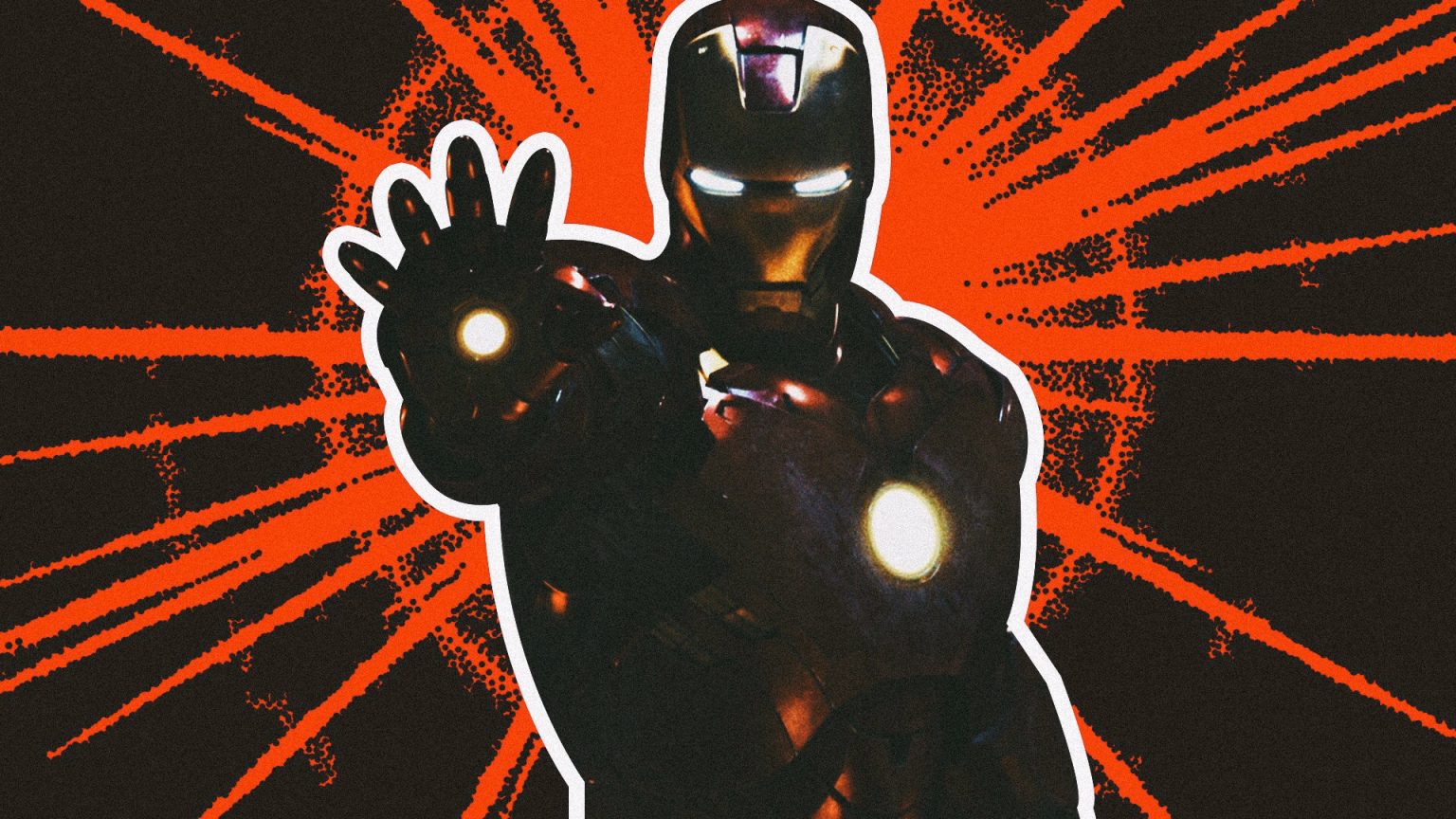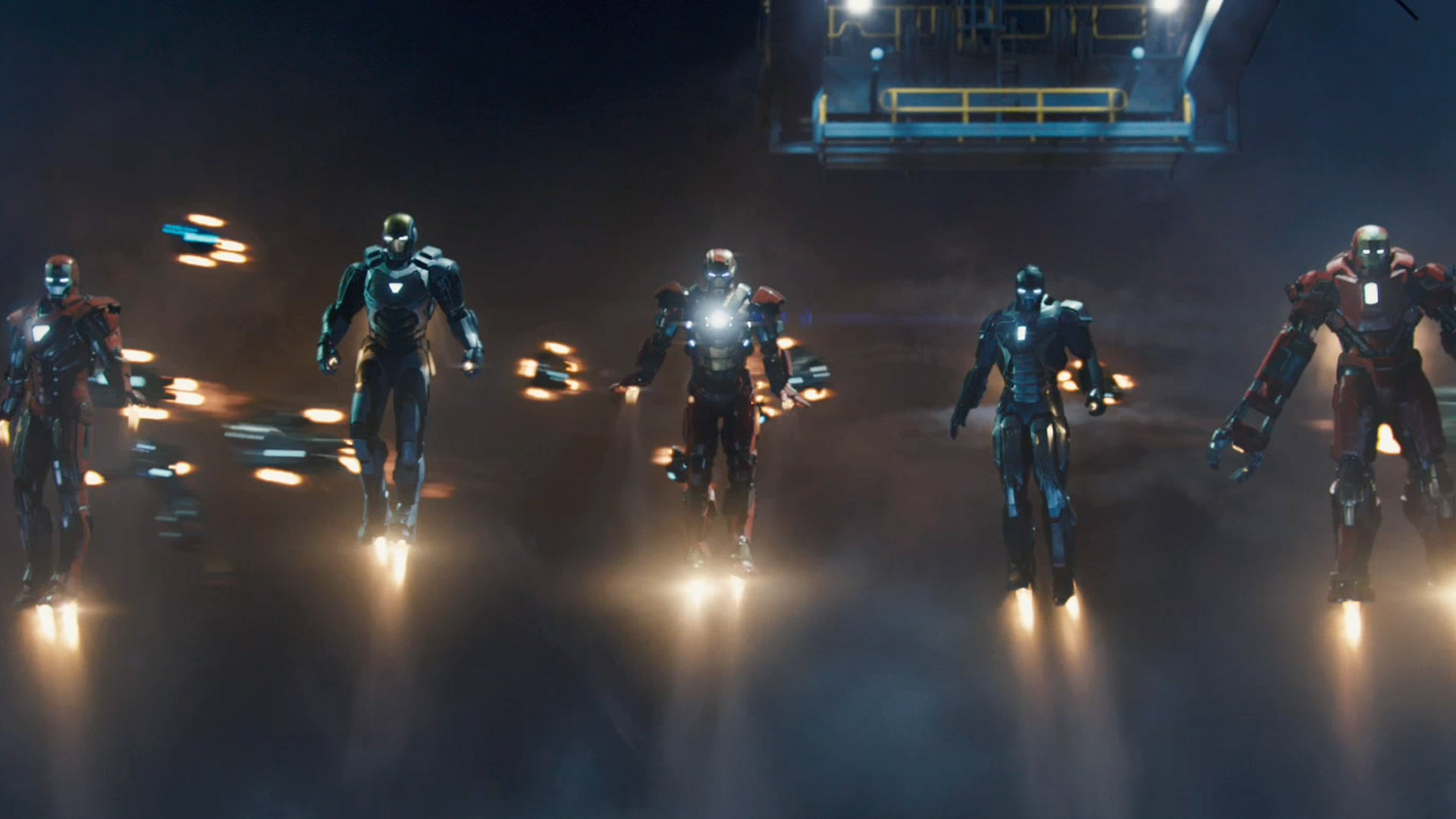Iron Man turns ten today, and, with it, the MCU. On this day in 2008, the skyward launch of Tony Stark’s super suit kicked off what would become the most lucrative franchise in film history. It’s fitting that the tenth anniversary falls immediately after the opening weekend of Avengers: Infinity War, a sprawling mélange of forty-plus characters that is the apotheosis of a decade of universe-building. And yet, when we look back at the MCU’s inaugural film, we see a movie that, while in many ways precisely the kind of shiny, quippy tentpole one would expect to have jump-started the media corporate behemoth of our time, also feels different from many of the MCU’s more recent entries.
One key disparity has to do with scale, a gap that can be traced by looking at the climax of Iron Man 3, in which Tony summons a legion of remotely piloted Iron Man suits to join the battle with the “Big Bad.” More suits mean that the value of each one diminishes (this may be an unpopular opinion, but to me, Iron Man 3 does to the Iron Man suit what Aliens did to the xenomorph from Alien), and as a suit, after inconsequential suit gets destroyed, the spectacle starts to feel as empty as these hunks of metal themselves, evoking the assembly-line logic governing much of the Marvel industrial machinery, which often simply takes past successes and reproduces them in a degraded form.
In contrast, the first Iron Man focuses on one man and one suit. It takes half the movie for him to wear the thing, and the preceding scenes involve lots of tweaking and tinkering of both the suit and its wearer. Tony, the weapons manufacturer/billionaire/playboy with an outsized ego, is kidnapped by terrorists near the start of the film, an experience that leads him to realize that his weapons, which were allegedly meant to maintain world peace (read: American hegemony) via the logic of mutually assured destruction, was being used to slaughter innocent civilians. He escapes by building a prototype of the Iron Man suit, and, now living on borrowed time, decides to ditch war profiteering and instead help people by perfecting the technology he debuted while in captivity.
Iron Man works largely because it establishes stakes through focusing on process i.e. the time and strain that go into honing technology and personal character alike. When Tony takes to the skies for the first time, it is exhilarating because earlier scenes showed the painstaking workflow that went into designing the suit. When he later drops fully suited into a village to save civilians who are under attack, the moment is similarly thrilling because we’re seeing the fruits of his labor pay off. This scene, though brief, remains one of the finest action scenes in the MCU because it internally reproduces the ethos of process. Like Tony’s first flight, this altercation is a test run for both the technology of the suit and Tony’s new role as a superhero—each thunk of metal-on-body and each fired missile feels like a triumph and a statement. Fittingly, director Jon Favreau opts for few cuts and clean choreography so that we can track Tony’s progress with each punch thrown and every villain sent flying through a wall of cement.
The film’s sympathy for the process extends to Tony’s development as a person. When a reporter, whom Tony had bedded and then unceremoniously dumped in an early scene, takes an accusatory tone toward him about his and his company’s conduct, the viewer’s instinct is to come to his defense because, though we understand her irritation and recognize his imperfection, we’ve seen how far he’s come since the start of the film.
The question becomes: does he come far enough? Indeed, what was radical about Iron Man in 2008 was precisely that it foreclosed the possibility of total reform; Tony Stark was, by definition, a douchebag, and that was what made him so compelling. In an age where the brooding “anti-hero” had become normalized to the point where the “anti” part could pretty much no longer be applied, the definition had to be adjusted. Instead of characters who were “nobly” dark and gritty, we got a cocksure objectifier of women who was good at everything and knew it. Common decency suggested that this wasn’t the kind of person you’d want to be friends with, and yet there was something about his brashness, his unconcern for “proper” ways of behaving, that felt refreshing.
The issue is, in this model of anti-heroism, Tony’s demeaning attitude toward women gets subsumed under his wild-card persona. In celebrating the latter, the film permits the former and even treats it with hearty affection, as in a scene when the stewardesses on Tony’s private jet are shown pole dancing for him while he lounges with a drink in hand. This moment serves no narrative purpose beyond saying, “Look at Tony being Tony again!”, but it is precisely this tone of endearment that is dangerous because it trivializes and even celebrates Tony’s sexism as being simply part of his loose-cannon charm. In our age of another irresponsible billionaire playboy in a position of power, this scene plays even worse. Indeed, many seemed to endorse Donald Trump simply because he, like Tony, broke the rules of the game. Though Trump’s list of offenses runs long, there was the sense that, for many, the sheer magnitude of his unfitness for office was part and parcel of his appeal.
Though the MCU has yet to surpass Iron Man’s small-scale panache, it has evolved with the times in admirable ways, leaving behind that film’s more questionable elements. Female and POC representation has increased, while Tony himself, though still the swaggering smart-mouth from ten years ago, has largely shed his sexism. If we returned to the motif of progress, we can say that the MCU has yet to mature narratively and aesthetically to the point of providing a satisfying sense of growth to those who’ve been watching since day one. But in terms of how its politics have changed since Iron Man, the franchise seems to be heading in a good direction.





